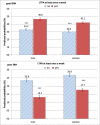Trends in self-rated health among the elderly population in Germany from 1995 to 2015 - the influence of temporal change in leisure time physical activity
- PMID: 31992257
- PMCID: PMC6988275
- DOI: 10.1186/s12889-020-8218-7
Trends in self-rated health among the elderly population in Germany from 1995 to 2015 - the influence of temporal change in leisure time physical activity
Abstract
Background: Against the backdrop of rising statutory retirement age in Germany, we analyzed time trends in self-rated health (SRH) among the elderly population between 50 and 70 years of age and explored the mediating role of leisure time physical activity (LTPA) on the relationship between time period and self-rated health (SRH).
Methods: We used longitudinal survey data (n = 23,161) from a national panel study (GSOEP) to analyze time trends in SRH and regular LTPA (at least once a week) by means of Generalized Estimation Equation (GEE) analysis for logistic regression. The Karlson-Holm-Breen (KHB) method was applied for decomposing trend effects into direct and indirect parts via LTPA. In addition to odds ratios (OR), we illustrated the results by means of predicted probabilities and average partial effects (APE).
Results: Over time, the predicted probabilities of good SRH and regular LTPA increased while those of poor SRH decreased. After adjusting for socioeconomic status (SES) 53.4% of the trend in good SRH in women (OR = 1.34 / APE = 6.8%-points) could be attributed to the rise in regular LTPA. In men, the remaining smaller effect (OR = 1.13 / APE = 2.7%) could be fully assigned to temporal changes in regular LTPA. With respect to poor health we found a suppression effect of LTPA in the adjusted model, indicating that without improvements in regular LTPA over time an increase in poor SRH would have occurred.
Conclusions: The increase of regular LTPA accounted for improved SRH from 1995 to 2015 among the elderly, indicating that promoting LTPA might be a key factor to raise healthy working life expectancy.
Keywords: Leisure time physical activity; Mediation; SRH; Time trend.
Conflict of interest statement
The authors declare that they have no competing interests.
Figures




Similar articles
-
Is the association between physical activity and healthcare utilization affected by self-rated health and socio-economic factors?BMC Public Health. 2015 Aug 1;15:737. doi: 10.1186/s12889-015-2079-5. BMC Public Health. 2015. PMID: 26231379 Free PMC article.
-
Development of gender inequality in self-rated health in the life-phase of raising children in Germany from 1994 to 2018 - A decomposition analysis of socioeconomic, psychosocial and family-related influencing factors.SSM Popul Health. 2022 Jul 31;19:101183. doi: 10.1016/j.ssmph.2022.101183. eCollection 2022 Sep. SSM Popul Health. 2022. PMID: 36046064 Free PMC article.
-
Associations of occupational and leisure-time physical activity with self-rated health in Korea.Prev Med. 2022 May;158:107022. doi: 10.1016/j.ypmed.2022.107022. Epub 2022 Mar 17. Prev Med. 2022. PMID: 35307369
-
Leisure Time Physical Activity and Associated Factors among Adults in Estonia 2000-2018.Int J Environ Res Public Health. 2021 Mar 18;18(6):3132. doi: 10.3390/ijerph18063132. Int J Environ Res Public Health. 2021. PMID: 33803621 Free PMC article.
-
A systematic scoping review: Resources targeting the training and education of health and recreation practitioners to support physical activity among people with physical disabilities.Disabil Health J. 2019 Oct;12(4):542-550. doi: 10.1016/j.dhjo.2019.06.007. Epub 2019 Jun 15. Disabil Health J. 2019. PMID: 31231020
Cited by
-
A Space-Time Analysis of Rural Older People's Outdoor Mobility and Its Impact on Self-Rated Health: Evidence from a Taiwanese Rural Village.Int J Environ Res Public Health. 2021 May 31;18(11):5902. doi: 10.3390/ijerph18115902. Int J Environ Res Public Health. 2021. PMID: 34072884 Free PMC article.
-
Living longer, working longer: analysing time trends in working life expectancy in Germany from a health perspective between 2002 and 2018.Eur J Ageing. 2022 May 23;19(4):1263-1276. doi: 10.1007/s10433-022-00707-0. eCollection 2022 Dec. Eur J Ageing. 2022. PMID: 36506674 Free PMC article.
-
Associations of fruit & vegetable intake and physical activity with poor self-rated health among Chinese older adults.BMC Geriatr. 2022 Jan 3;22(1):10. doi: 10.1186/s12877-021-02709-6. BMC Geriatr. 2022. PMID: 34979973 Free PMC article.
-
Non-linear relationship between body mass index and self-rated health in older Korean adults: body image and sex considerations.Epidemiol Health. 2023;45:e2023061. doi: 10.4178/epih.e2023061. Epub 2023 Jun 20. Epidemiol Health. 2023. PMID: 37402412 Free PMC article.
-
Self-Rated Health and its Impact on Survival of Older Adults.Adv Biomed Res. 2024 Jul 29;13:45. doi: 10.4103/abr.abr_34_23. eCollection 2024. Adv Biomed Res. 2024. PMID: 39411700 Free PMC article.
References
MeSH terms
Grants and funding
LinkOut - more resources
Full Text Sources
Medical
Research Materials
Miscellaneous

